Mark IX (tank)
| Mark IX | |
|---|---|

armored personnel carrier |
|
| General properties | |
| crew | Driver, mechanic, commander, machine gunner |
| length | 9.7 m |
| width | 2.5 m |
| height | 2.64 m |
| Dimensions | approx. 27 t |
| Armor and armament | |
| Armor | 10 mm |
| Main armament | 2 × machine guns 7.7 × 56 mm R |
| Secondary armament | 16 gun hatches |
| agility | |
| drive | Ricardo 6-cylinder petrol engine 150 PS (112 kW) |
| suspension | unsprung |
| Top speed | 6.9 km / h (road / terrain) |
| Power / weight | 5.6 hp / t |
| Range | ? km |
The Mark IX was a British armored personnel carrier of the First World War and can be considered the first armored transport vehicle in the world.
development
During the first attack operations carried out with tank support, it quickly became apparent that the infantry could not keep up with the tanks. However, this was not due to the speed of the tanks, which due to their design did not move faster than walking pace anyway, but to the often massive defensive fire from infantry weapons - which was the real reason for using armored vehicles. Key positions that had been bought at a high price often had to be given up again, as the supporting infantry had remained in the rear.
First considerations for solving this problem were to "squeeze in" some infantrymen in addition to the crew of each tank. It quickly became clear, however, that the breathing air inside the tanks, which was not of particularly good quality, became so bad that the "mounted" infantry, if they did not pass out within a very short time, could not be used for up to an hour after leaving the poisoned atmosphere was.
For this reason, Lieutenant GR Rackham received the order in the summer of 1917 to develop an armored vehicle specially designed for the transport of infantry. Initial attempts were delayed because attempts were made to design the project in such a way that it could take over the role of the Mark VIII tank in the event of an incorrect development . For this reason the vehicle was also called a tank .
However, this intention was soon abandoned and in September 1917 one began with the production of two prototypes as pure troop transports at Armstrong, Whitworth & Co. in Newcastle-upon-Tyne . However, the right was reserved to convert the device into an all-purpose support vehicle if necessary. The following year the project was approved and the construction contract for 200 units was awarded to the Marshall, Sons & Co. tractor factory in Gainsborough ( Lincolnshire ). At this point it was already clear that the extended Mark V was also out of the question for infantry transport.
Until the armistice only three copies were ready for use. A total of only 34 pieces were made.
description
Since there was no time for a completely new development, the cover of a Mark V was used, which was extended to 9.73 meters. The engine was housed in the bow, the gearbox in the stern. All components that were not absolutely necessary inside the shell were relocated to the outside, so that in the end an interior space four meters long and 2.45 meters wide was available. This should be enough to transport a total of 30 men (according to official information, fifty men were already thought of) or ten tons of material. In order to ensure the necessary rigidity of the tub, the floor was reinforced with heavy steel beams. No seats were provided for the crew to be transported and they had to be careful of the cardan shaft rotating in the middle of the vehicle.
The crew consisted of the driver, the commander (to the right of the driver), a mechanic and a machine gunner who could operate a machine gun in a stern hatch. A second machine gun was in the front. There were eight gun hatches on each side of the hull (one in each of the four doors) through which the infantrymen could fire outside. This made the Mark IX a real armored personnel carrier .
The use of 10 mm thick armor plates resulted in a weight of 27 tons and - as a result - a maximum speed of 7 km / h. The tank could also carry material in a container behind the commander's cupola on the roof. At 2.64 meters, this was also the highest point on the vehicle. Up to three loaded sleds could be towed at the same time.
Rackham tried to improve the vehicle by installing a larger muffler on the roof along with fans, but there was still no separate engine room. Due to this lack of space division, it was questionable whether the project would ever have achieved the goal of usable personnel transport in the order of magnitude of a combat-ready train.
The Mark IX continued to be used until a few years after the war. Because of the front section reminiscent of a pig's nose, the vehicle was commonly referred to as "The Pig".
One of the first three units was used as an armored ambulance, while another was converted into a floating tank by the Dollis Hill test site personnel . To do this, large air tanks were attached to the front and sides. The chain links were fitted with a kind of wooden paddle, which, when immersed in the water, gave the vehicle the necessary propulsion through the movement of the chains. Photos show the vehicle trying to swim in the Hendon Reservoir on November 11, 1918 . This particular vehicle is said to have been called "The Duck", but nothing is proven.
The only surviving specimen is in the Bovington Tank Museum.